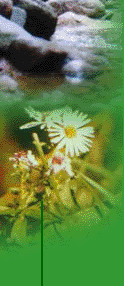ALGAE- aquatic plants which lack true roots, stems or leaves; important source of food for plant eaters and dissolved oxygen (from photosynthesis) in aquatic systems; may become overly abundant if excess nutrients are present, thus throwing the system out of balance.
AQUIFER- the underground formation of rock or sand which stores water; people pump water from aquifers with wells.
BACKPUMPING- the process of pumping water in the opposite direction than it would normally flow; routine backpumping into Lake Okeechobee was stopped in 1979.
BEST MANAGEMENT PRACTICE- a scientifically designed way of controlling natural resources; in the dairy business, a change in agricultural operation to improve the quality of water flowing from a farm.
BISCAYNE AQUIFER- a major aquifer supplying water to much of South Florida
CENTRAL AND SOUTHERN FLORIDA FLOOD CONTROL PROJECT- the C&SF project; a massive flood control and water supply system authorized by Congress in 1948 and constructed by the U.S. Army Corps of Engineers; includes 1,400 miles of canals and levees, 252 water control structures, 18 major pumping stations and 13 boat navigation locks.
ECOSYSTEM- the interrelated living and non-living things in a given area.
ESTUARY- a water body adjacent to a coastline where fresh water and saltwater meet; highly productive nursery grounds for many organisms.
EUTROPHICATION- a natural biological process in which a lake changes over time (ages) because of physical and biological changes; the process can be greatly accelerated when excess nutrients (especially phosphorous and nitrogen) are released into the water.
EVERGALDES AGRICULTURAL AREA- approximately 700,000 acres of former Everglades drained by C&SF Project; the peat/muck soils provide fertile ground for sugarcane and vegetable crops.
EVERGLADES NATIONAL PARK- a 1.4 million acre park at the southernmost tip of the Kissimmee-Okeechobee-Everglades ecosystem; created by Congress in 1947.
EXOTIC SPECIES- a non-native species found in a given habitat; the walking catfish, and the water hyacinth and hydrilla aquatic plants are examples.
FLOODPLAIN- the land along river banks which is periodically flooded when the river overflows.
GAMEFISH- a fish which is normally caught for sport and/or food.
GROUNDWATER- water which is found in underground formations of rock or sand called aquifers, in contrast to surface water found standing in ponds, lakes, streams or other wetlands.
LIMITING FACTOR- an environmental factor which regulates plant growth; for example, phosphorous functions as a limiting factor for plant growth in many aquatic systems.
NONGAME FISH- a fish mot normally caught for sport or commerce; most species of fish fall into this category; for example, Lake Okeechobee has 42 species of fish, only 12 of which are considered gamefish.
OVERDRAFTING- the process by which humans remove more water from an aquifer than is replaced by the process of recharge through percolation (sinking down) of rain water through porous soils.
PHYTOPLANKTON- microscopic (usually) drifting plants; a type of algae which often serves as the base/beginning of aquatic food chains.
RUNOFF- water washing off the land, streets, parking lots, etc., which contains sediment and dissolved substances such as chemical nutrients.
SALTWATER INTRUSION- the process by which saltwater seeps into a coastal aquifer, contaminating it as a ready source of drinking water; overdrafting can be a contributing factor.
SELECTIVE ADVANTAGE- a characteristic a species possesses which gives it a competitive edge over competing species in the process of natural selection; exotic species often outcompete native species because they lack natural predators.
SHEETFLOW- the process by which water moves almost imperceptibly, in shallow, wide sheets rather than collecting in creaks, streams, or rivers.
SOUTH FLORIDA WATER MANAGEMENT DISTRICT- formed in 1949 as the Central and Southern Florida Flood Control District; became the water management district as a result of the Florida Water Resources At of 1972 which created five districts in the state.
WATER CONSERVATION AREAS- large expanses (approximately 860,000 acres) of Everglades sawgrass wetlands which have been set aside to store water during times of flood and drought.
WATERSHED- the surface drainage area or hydrological boundary from which rainwater runoff flows into slough, creeks, and then rivers and on into a lake or estuary.
WATER TABLE- the point where one can find standing groundwater beneath the soil; the water table rises and falls depending on the amount of rainfall, human consumption and other factors.
|




